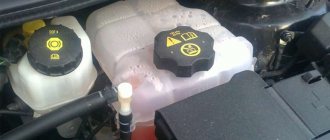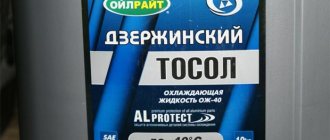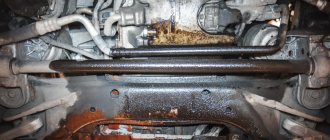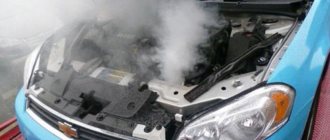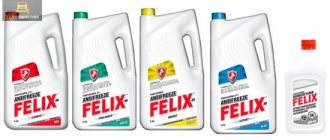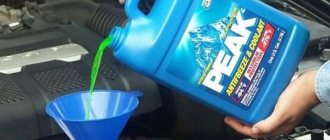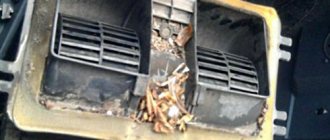- home
- Coolant
- …
Over time, instead of the usual blue, green, red (sometimes yellow) color, an incomprehensible dark liquid suddenly forms in the expansion tank of your car. Usually either black or dark brown. Moreover, this sometimes happens after replacing the coolant. So why does this happen? Why does antifreeze turn dark over time or immediately (after a couple of weeks)? Is it possible to drive or do you need to change it immediately - let’s look at the main reasons...
To begin with, I would like to say that antifreeze or antifreeze is not filled in for the entire service life of your car; after a certain mileage it definitely needs to be changed and you should not neglect these recommendations. Any manufacturer has this written in the operating instructions, usually about 40 - 60,000 km, rarely after 90 - 100,000 km. This run-up is characterized by various additives and the composition of coolants (currently there are classes G11, G12, G13). Accordingly, G13 will run the longest.
What antifreezes are ethylene glycol used in?
Now there are generally accepted standards, these are antifreezes G11 (G11+), G12 (G12+, G12++), and in our antifreezes (in fact, they belong to the G11 family). If you sort it by color, it is blue, green, red.
Now in more detail:
Safety. Ethylene glycol is a toxic liquid that can poison a person not only when ingested, but also through the pores of the skin and when inhaled! Therefore, they are now trying to reduce its use. It is worth noting that if a person remains in a room where this liquid has been spilled for a couple of hours, it can cause severe poisoning. And if it gets inside, it will lead to death in 60 - 70% of cases.
Temperature threshold. Do you know that pure ethylene glycol freezes at -12 degrees. However, if you break it up with water, you can reach temperatures of -40 to -50 degrees. Find out how to properly dilute such concentrates here.
Corrosion resistance. It should be noted that it corrodes almost all types of materials, metals (cast iron, aluminum, brass, copper, etc.), rubber. Therefore, the concentration of additives must always be sufficient.
Flammable Fires of antifreeze based on it are often possible, especially when water evaporates. So if there is only 15% water left, then it can simply catch fire. If the water level is 40%, then popping sounds are possible. So the water level should always be normal.
Now it is practically prohibited, in many European countries, here in Russia, as well as in neighboring countries - ALLOWED. Therefore, you need to handle antifreezes based on it very carefully; storing it at home is not recommended! Open storage is not recommended! Poisoning and even fire are possible. The time of ethylene glycol is passing, it is outdated and does not meet all the characteristics currently required.
What to do if the antifreeze has darkened
First of all, it is necessary to determine the exact reason why this happened. If the fluid is contaminated with engine oil, immediately check the integrity of the cylinder head gasket and heat exchanger parts. The identified malfunction should be quickly removed, since the combination of refrigerant with lubricant leads to engine malfunctions and further expensive repairs.
The easiest way to act is in a situation where the antifreeze has expired. It will be enough to remove the waste and after thoroughly flushing the system, pour fresh liquid into it.
The possibility of further use of refrigerant with a changed color is determined after checking the temperature conditions of the operating motor. If the engine does not overheat under load, antifreeze can still be used for some time. The coolant should be replaced if it has a strong odor and a black or brown color, and the engine is overheating.
This antifreeze needs to be replaced
Step-by-step instructions for replacing antifreeze:
- The waste liquid is completely drained from the engine cooling circuit.
- The expansion tank is removed from the engine compartment, thoroughly cleaned of dirt and installed in its place.
- Distilled water is poured into the system, its level is brought to normal after starting the engine.
- The car starts moving, after a few kilometers the engine turns off and the flushing fluid is drained from the cooling circuit.
- Such actions are repeated several times until the distillate drained from the system becomes clean and transparent.
- After this, fresh antifreeze is poured into the radiator.
How to flush the system other than store-bought products
You can use not only distilled water. Good results are obtained by using the following means:
- a composition of 30 g of citric acid dissolved in 1 liter of water effectively removes rust from parts;
- a mixture of 0.5 liters of acetic acid with 10 liters of water effectively washes away dirt and deposits;
- drinks such as Fanta or Cola cleanse the system well;
- Milk milk poured into the radiator perfectly removes contaminants.
Methods for solving the problem
To solve the problem with rusty antifreeze, the car enthusiast needs to know the exact cause. If an emulsion or parts of engine oil appear under the expansion tank cap, then you need to look for the fault as quickly as possible. It is recommended to pay attention to:
- Cylinder head gasket.
- Heat exchanger.
- Pipes and other types of gaskets.
As a rule, in the first two places there is often contact between oil and coolant. After combining the liquids, the cooling system begins to become clogged and the engine malfunctions. After removing the cause, the systems are flushed and the coolant is replaced.
It is much easier to solve the problem if the antifreeze has expired. It will be enough to replace the liquid, but first rinse everything with special products or distilled water. Rinsing is carried out until the water is clear, without a red tint.
Why did Antifreeze darken and turn brown and what to do
Antifreeze is one of the main fluids in a car. The operation of the entire cooling system and the functioning of the power plant directly depend on its quality. Often, during operation, the refrigerant changes its color, and then urgent measures have to be taken. Why Antifreeze turned brown and what this is connected with will be discussed in our article.
What will happen if you don’t change it in time?
You must understand that after prolonged use the refrigerant loses its original properties. It circulates within the system, but its effectiveness gradually decreases. This causes the cooling unit to suffer heavy loads, which negatively affects the engine.
Each manufacturer sets different terms for replacing the refrigerant, but, in fact, the service life is the same for almost all machines.
Approximate period of use of antifreeze:
— G13 — about 6 years.
On average, it is recommended to change antifreeze every three years.
Causes of changes in color and odor of liquid
Experienced motorists know that over time, inside the expansion tank, instead of the usual shades, you can see an incomprehensible dark liquid. The process of refrigerant changing color is not normal.
In most cases, Antifreeze acquires a brown tint or completely black; in rare cases, it foams, darkens, and sometimes comes with flakes. And often this happens about 2-3 weeks after the fluid change.
Any darkening of the antifreeze indicates important problems that cannot be ignored. It is likely that the antifreeze has expired. This can be determined by the color transformation. First it changes from blue to green, then to transparent. Or it turns yellow and then completely colorless. Thus, the loss of the initial color indicates that the liquid is unsuitable for further use. At the same time, the refrigerant acquires a strong and unpleasant odor.
But often the problem is caused by the following reasons:
— The surfaces of metal components and parts that the liquid washes have oxidized. This is a common problem in used cars. Rust appears on them, it gets into the antifreeze circulating throughout the system. This changes the color.
— Low-quality antifreeze was poured into the expansion tank, without restraining additives. As you know, an overly aggressive liquid easily eats through rubber materials: hoses, pipes, gaskets. In this case, the refrigerant will be black.
— Instead of antifreeze, ordinary water is often used. This happens, for example, on the road, when there is no coolant at hand and one of the pipes breaks. You have to fill it with tap water, which over time will form scale on the walls of the radiator.
— Antifreeze has lost its properties and changed color. Its protective additives have stopped working and the fluid is no longer able to withstand high temperatures. Already at 90°C foam can form.
— Engine oil got inside the coolant. This happens for various reasons, usually the cylinder head gasket is drying out.
— Adding chemicals to the radiator. Some motorists believe in miracle additives that supposedly quickly eliminate leaks in the radiator. In fact, there is no benefit from them, but the color of the refrigerant changes greatly, as it reacts with these substances.
— The antifreeze was replaced, but the system was not flushed for a long time. Sediment has accumulated. When new fluid is poured in, all contaminants are mixed with it, and the antifreeze turns black or becomes cloudy in color.
— The cooling system or oil heat exchanger, which is installed on many modern cars with powerful engines, is faulty. Especially if the antifreeze has turned black.
— It is noteworthy that in some cases antifreeze turns red. This happens over time, and the cause is the reaction of the engine subjected to excessive loads. For example, if the car is often stuck in traffic jams or the driver’s driving style does not comply with the rules, then the coolant quickly loses its properties. In addition, the red color indicates the presence of corrosion on the system elements.
First of all, given the importance of the operation of the power plant, and in order to protect yourself from unnecessary costs for major repairs, it is recommended to check the engine. If obvious overheating is not observed, the antifreeze is still suitable for further use, then the color change is clearly caused by corrosion in the tubes or burnout of additives. It would be a good idea to update the refrigerant in this situation, although it is not necessary.
On the contrary, if the antifreeze has changed color to black or brown and has a strong smell, and the engine often overheats, then you need to replace the coolant as quickly as possible.
In order to change the fluid, it is recommended to do the following:
— Drain all antifreeze from the system.
— Remove the expansion tank, and then thoroughly clean and rinse it. There are many ways to do this. You can pour small crushed stone inside, then vigorously shake the container for several minutes. Remove dirt from the tank and rinse with clean water.
Replaced it after a couple of weeks, dark again
This also happens, it seems like I drained the old fluid and poured in a new clean one, but a couple of weeks passed and it’s dark again. WHY? YES it's simple. You didn't flush the system, THIS IS A GREAT MISTAKE!
When the antifreeze is new, it begins to wash away all the old plaque from the walls and pipes inside. It is because of this that even new liquid will quickly turn back into brown.
Therefore, we remember - be sure to rinse.
Now we are watching the video version.
I’ll end here, I think my article and video were useful to you. Sincerely yours, AUTOBLOGGER.
( 49 votes, average: 4.51 out of 5)
Similar news
Is it possible to mix antifreeze and antifreeze (red, green, blue). TO.
Protective mesh for the radiator grille. To bet or not?
Is it possible to pour water instead of antifreeze: winter - summer
What to do?
If the color of antifreeze changes, it is simply necessary to eliminate the problem as soon as possible. This is especially important when an oil emulsion appears in the system. In this case, the engine must not be started until the fault is eliminated. Usually the cause is a blown engine head gasket.
If rust appears, you should simply replace the antifreeze. But, before filling in new coolant, it is necessary to flush the system, otherwise the problem will recur.
conclusions
. Problems with the cooling system are not uncommon. In this regard, the question of why antifreeze (antifreeze) turned rusty or brown is not rare enough. This deficiency occurs quite often, so you need to know how to eliminate it.
Solution
It all depends on what exactly led to the change in coolant color. If you see an emulsion or drops of engine oil in the expansion tank, we advise you to address the problem as soon as possible. You need to dig towards the cylinder head gasket or heat exchanger. Only in these places can contact between engine oil and antifreeze usually occur. You should not delay it, since such a mixture will clog the system, and the engine will not cool properly. In such a situation, after eliminating the cause of the emulsion, the cooling system is thoroughly flushed and the antifreeze is replaced.
If the reason for the appearance of a brown (rusty) color of antifreeze is the end of its service life, it only needs to be replaced.
Important! In any case, flush the engine cooling system. Use only distilled water for this. Rinse until the water is clear. Only then fill in new coolant.
If you replaced the antifreeze, some time has passed (days or weeks) and its color has changed again, this means that the cooling system flush was not done in good faith.
Why does antifreeze turn brown - there is an answer!
Every motorist should periodically check the fluid level in the expansion tank of the engine cooling system. This is the same procedure as checking the oil level, which must also be performed regularly. And now, the next check shows that the antifreeze (or antifreeze) has changed its usual color to rusty or brown. We all know that coolant should be red, blue or green. What could be the reason for the change in the original color of antifreeze (antifreeze)? Is it possible to continue using such a car or does the problem need to be solved?
Antifreeze manufacturer's recommendations
Each country involved in the automotive industry produces coolants based on its own accepted standards. Only such antifreeze is also exported. That’s why there is such a rich assortment of cooling system fluids on the shelves of car dealerships, of different brands, with their own characteristics and service life.
In order to somehow streamline the current situation, antifreeze manufacturers themselves began to use for their products the classification used by the Volkswagen concern, which divided liquids into three classes with their own recommended replacement periods: G11, G12, G13.
When to be wary
- The coolant darkened greatly and acquired a shade that it could not achieve naturally.
- You can see rust in the liquid, the color itself looks rusty.
- The change in shade is combined with inclusions of oil or other liquid in the antifreeze, which should not be in the cooling system during normal operation.
If a change in color leads to the development of an unpleasant odor, the appearance of smoke or other alarming signs, it is necessary to urgently carry out repairs: this may indicate serious deviations in the operation of the systems.
Natural shade change
Over time, the life of most liquids is exhausted, additives settle on the elements of the cooling system, protecting them from corrosion, and mixing with other substances (sometimes car owners add liquid of a different shade, compatible with the original one) leads to a change in the final color. It is important to understand: high-quality antifreeze changes color slightly and gradually, becoming a little paler or, conversely, darker over time. There should be no serious deviations in shade due to natural changes. If they are, you should check the machine and the fluid itself: repairs may be necessary.
Read also: Why roads are washed in the rain
Causes of darkening
In practice, there may be several reasons for darkening. Below we will look at the main ones:
- The service life has expired
. In this case, part of the additives that make up the antifreeze is destroyed, and its color changes accordingly. The reason is quite understandable and natural; - Antifreezes are active substances. If specialized additives are not added to them, or low-quality components are used, then destruction of the rubber parts included in the cooling system is possible. In this case, a black suspension will be observed in the liquid;
- Oxidation
of the walls of the engine jacket. When water enters the system, metal corrosion begins. This leads to the formation of a large amount of rust. In this case, the antifreeze turns brown or rusty; - Boiling
.
Here again the main reasons are either water ingress or antifreeze aging. Let us recall that the normal boiling point for this substance is 120°C
; this temperature allows for normal engine cooling under standard operating conditions.
If water enters the system, boiling begins already at 90°C
. This leads to the formation of bubbles, as well as changes in color and other characteristics of the antifreeze; - Adding water
to antifreeze. This happens either out of ignorance, or in cases where there is no antifreeze on hand, but it is necessary to add it to the system. For example, during long trips, when you find a leak in the system at a distance from shops. In this case, you will get both oxidation and possible boiling. To avoid this, always carry a supply of coolant with you; - Contact with engine oil. This usually happens due to careless maintenance;
- Adding additives
. Nowadays there are a large number of different substances on sale that supposedly improve the performance of the cooling system. Here you can find products to eliminate leaks and substances that clean the system. But, in practice, it is unknown how the additive will interact with your brand of antifreeze. Such an additive can also lead to a change in coolant color; - There is a white coating
on the walls of the expansion tank; if you check the oil level, there will be a coating there too. One of the gaskets in the engine burned out, and the oil began to mix with antifreeze. If the problem is not corrected, the motor will jam. To clarify the diagnosis while the engine is running, open the radiator cap; whitish smoke will come out.
What is coolant
Coolant is a substance that circulates through the components of the power unit and maintains optimal temperature conditions, cooling it if necessary. During movement, engine parts generate large amounts of thermal energy as a result of friction. An uncontrolled increase in temperature provokes overheating of the motor.
How long does it take to replace antifreeze in a car? Engineers have developed a forced circulation system, the main role in which is assigned to antifreeze. Due to its chemical composition, it can encounter and withstand high temperatures without boiling or evaporating. For comparison, water would have to be added every 50 kilometers of driving. This is not just another move by marketers, but a necessity for the normal functioning of every motor vehicle.
Main reasons
It should be noted that antifreeze, like oil, has a certain shelf life. Often replacement is required every 50,000 km, but the figure is average and depends on the quality of the fluid and the manufacturer.
There are several main factors why antifreeze turns rusty in color. The main ones are:
- The expiration date has expired. A brown tint indicates that the additives in the material can no longer perform their intended functions and precipitation begins, which causes a color change.
- Motor overheating. The problem may lie in untimely change of fluid, and after the end of its service life it quickly boils and the original shade changes. In addition, overheating of the motor can be due to many other reasons, which also cause a rusty color.
- Oxidation of parts. The cooling system contains metal structures that can rust and change the color of the antifreeze. The problem is typical for long-term use of a liquid that can no longer protect the metal surface. The natural oxidation process begins.
- Destruction of pipes. Without a scheduled replacement of the coolant, it causes rubber products, namely pipes, to become unusable; they are gradually destroyed, and their parts end up in the liquid itself, but the color will often be black, not red.
- Water instead of antifreeze. During leaks, many people use water as a temporary alternative. Such measures should be used in extreme cases, and after water it is important to thoroughly rinse the system and add antifreeze. If you do not follow the rule, then metal parts will rust from water and in the future change the color of the coolant.
- Oil ingress. If the gaskets break, oil from the engine can enter the cooling system and change color during mixing. In this case, the antifreeze will not only be rusty, but an emulsion will appear in the tank, which resembles condensed milk in color and consistency.
- Use of chemistry. Radiator leaks often appear while driving; in emergency situations, leak removal additives, sealants, and other chemicals can be used. They help for a short time, and the antifreeze itself quickly turns brown.
Understanding what the reason is, it is necessary to eliminate it and replace the fluid with a new one. Leaving the process to chance is fraught with consequences. The main danger is engine overheating, which causes serious and expensive repairs.
In some cases, even after changing the antifreeze, it may turn red after a couple of weeks. The problem arises due to non-compliance with basic rules. Namely, that after removing the main cause, the system must be flushed, otherwise the antifreeze will quickly turn red and its properties will be lost. The new fluid in the system begins to wash away the old plaque, gradually becoming colored.
Why does the coolant in the engine darken?
If the coolant has not yet reached its full mileage, but has already darkened, this does not indicate anything good. Not only will you need to change the antifreeze itself, you also need to find out the reason that led to this problem. The following are the main reasons why the coolant in a car engine darkens:
- Low quality antifreeze. Unfortunately, antifreeze, like any other consumable for a car, is often counterfeited by pouring something into a canister of coolant that does not have all the necessary properties. Accordingly, such a liquid may have a faster service life, or it may not be able to competently perform its duties at all, which is why the metal elements with which it comes into contact will begin to oxidize and rust will appear. It is this that will cause the darkening of the antifreeze;
Destruction of rubber elements. If antifreeze does not work properly, it can negatively affect not only the metal elements of the system, but also the rubber ones. That is, the coolant will begin to destroy hoses, pipes and other rubber components with which it comes into contact. This will cause rubber particles to begin to appear in the antifreeze reservoir, and the liquid itself will darken and become blacker;- Oil gets into the coolant. Unfortunately, this is a fairly common problem that any driver can unexpectedly encounter. It is marked not only by blackening of the antifreeze, but also by increased oil consumption. Oil can get into the antifreeze through the heat exchanger or the cylinder head gasket. If this problem occurs, it is necessary to eliminate it as soon as possible, since oil negatively affects the properties of the coolant;
- Antifreeze boiling. The problem may arise due to poor quality coolant or the development of additives. If new, high-quality antifreeze can easily withstand temperatures above 120 degrees, then low-quality or used antifreeze risks starting to boil at temperatures even below 90 degrees. After boiling, the coolant changes color;
- Mixing antifreeze with water. While driving, a driver's hose may break, causing coolant to start pouring out. If the leak is eliminated, you can continue driving to the service center, adding regular water to the coolant. Of course, such water has a negative effect on the components of the system and must be replaced as soon as possible. It is very likely that when you get to the service center, the liquid in the tank will already be dark.
As you can see from the reasons described above, most often the darkening of antifreeze is associated with its quality. If the fluid has expired or is of poor quality, it will most likely darken. You can consider the darkening of antifreeze as a signal that it needs to be changed, but remember that often such a problem can arise due to a number of reasons, and not just because of the quality of the liquid itself.
Important: When replacing coolant, be sure to flush the system. If the antifreeze has darkened, this most often indicates that the system is seriously contaminated, and it is better to flush it several times, you can even use various specialized products.
( 440 votes, average: 4.54 out of 5)
What will happen if you don't change?
The question, as they say, is rhetorical. Any even the most advanced “cooler” loses its properties over time and can no longer work 100%.
If you do not change it, then the system is likely to overheat (especially in summer in traffic jams), which can lead to engine overheating. And this, to put it mildly, is not good, it will either jam, or the oil scraper and compression rings will wear out - power will be lost and there will be a high consumption of engine oil. In any case, sooner or later such a power unit will be needed.
Is it possible not to change the coolant and continue driving?
All types of coolant have a certain service life. After some time, the antifreeze will lose its characteristics. What does this lead to? That's right, to engine overheating! What does overheating lead to? In the best case, engine power will seriously drop and oil consumption will increase. At worst, it will simply jam and you will not be able to continue moving.
If antifreeze (antifreeze) darkens, it is better to solve the problem immediately, since in the future this may lead to more serious difficulties that require significant financial investments. Change the fluid in your car's engine cooling system in a timely manner and remember that prevention is always cheaper than repairs!
How often to change antifreeze
When a driver notices that his antifreeze has turned brown, he may decide to replace it, considering that its service life has expired.
In fact, this is not always the case, and antifreeze should be changed depending on the mileage of the car, and not on its color. Different car manufacturers recommend different antifreeze change intervals. On average, it is customary to change the coolant every 40-60 thousand kilometers, but on some cars the replacement period can reach up to 90-100 thousand kilometers.
Please note: The frequency of antifreeze changes depends not only on the car, but also on the liquid itself. Antifreeze can be of various classes, now the most common are G11, G12, G13
Coolant class G13 retains its properties for the longest possible time, thanks to the use of higher quality additives.
Why did antifreeze turn brown?
Antifreeze color
Antifreeze is a special coolant used in a car. The main function of this fluid is to regulate the temperature of the engine during operation. Antifreeze is usually made in blue color. But it happens that certain varieties of this coolant are produced in a different color. For example, the Tosol - 65 brand is red.
Brown antifreeze that was drained from the car
If the color of the antifreeze has changed, it usually means one thing: the coolant has lost its properties. First, the antifreeze becomes greenish, then yellow and finally colorless.
Thus, the loss of color for antifreeze is characterized, first of all, by the fact that the liquid gradually becomes unusable. The unsuitability lies in the development of corrosion inhibitors that interfere with the normal operation of the car.
The speed at which antifreeze changes its color indicates the following:
- If the antifreeze turns yellow after about five hundred hours of operation, then there is a fact of incorrect engine operation, that is, the engine is overheating - above 105 degrees
- If the antifreeze turns green during the same five hundred hours of operation, then the engine runs without overheating
But antifreeze can turn black, brown, and red. There are several explanations for the change in color of the coolant during vehicle operation:
- Antifreeze has lost its properties
- There may be a breakdown of the radiator with the stove or the formation of a corrosion process of the radiator
- A corrosion process has occurred in the engine system
Here are the main reasons why antifreeze turned black or brown.
If the antifreeze turns brown, urgent replacement is necessary.
If a change in the color of the coolant is detected, first of all it is necessary to check the operation of the car engine.
If no obvious overheating is observed during operation, then the antifreeze is still suitable for use and works correctly. The color has changed, possibly due to burnt-out additives or due to rust in the pipes.
In such a situation, replacing the coolant will not be superfluous, but, on the other hand, it is not required.
In the case when the antifreeze has turned brown or black, and there is obvious overheating of the engine, then in such a situation it is necessary to replace the used fluid with a new one as quickly as possible.
Why did antifreeze turn red?
The antifreeze in the reservoir has turned brown
Sometimes antifreeze becomes reddish over time. The reason for this may be the intensive operation of the engine, which leads to prolonged high temperature loads.
For example, if the car very often gets into traffic jams or moves for a long time at maximum speed. That is, the antifreeze cannot cope with the load and begins to acquire a red color.
This color, by the way, is obtained as a result of the dissolution of iron particles from cylinder blocks.
The reason for this process may be a low-quality or outdated antifreeze formulation, which simply cannot cope with the loads on the car engine.
The fact is that the modern design of cooling systems in cars (even in modern VAZs) is made in such a way that excessive pressure often occurs in the antifreeze, and the boiling point rises to one hundred twenty or one hundred thirty degrees.
And at such high temperatures, corrosion inhibitors cease to provide the necessary protection. From this we can conclude that antifreeze, which was produced in the Soviet Union, is not always suitable for modern vehicles.
How to recognize a cooling system malfunction
The most common malfunction of the cooling system is a leak of antifreeze - a coolant that increases engine efficiency and protects it from overheating. Antifreeze also allows you to save on fuel.
A car engine operates most productively in a certain temperature range. When the engine temperature begins to exceed its permissible value, you may observe the following symptoms:
- a plume of steam is pouring out from under the hood;
- White smoke is visible from the muffler;
- the stove in the cabin begins to cool the air rather than warm it up;
- the dashboard received a signal about engine overheating;
- The thermometer needle has reached its maximum value.
Antifreeze is leaking
Several signs may appear at once, or maybe just one, but in any case, you should immediately turn off the car’s ignition.
How to solve a problem
it is important! If the antifreeze has darkened or acquired a rusty tint, it definitely needs to be changed. A change in coolant color indicates that the coolant has lost its ability to protect the internal surfaces of the system from harmful influences and ensure normal engine operation. It is equally important to establish the reason why the refrigerant has changed color. If it is wear and has expired, it will be enough to flush the cooling system and add new high-quality fluid. If the cause is related to a malfunction of one of the vehicle components, it must first be eliminated.
You need to check:
- pipes and other rubber elements;
- cylinder head gasket;
- heat exchanger
If you have symptoms of an overheating engine, you should conduct a thoughtful diagnosis to find out why it is overheating and eliminate any possible problems.
Replacing the cylinder head gasket
. If, as a result of the diagnosis, it was determined that the antifreeze changed color to brown and turned into an oil emulsion due to damage to the cylinder head gasket, the car is sent for repair. The machine cannot be operated until the seal has been replaced. This type of work is performed in a car service center or independently. If you intend to replace the gasket between the cylinder head and the cylinder block with your own hands, you need to do the following:
- buy a new part (by VIN code);
- dismantle attachments - filters, pipes, etc.;
- remove the cylinder head cover;
- unscrew all cylinder head mounting bolts;
- remove the cylinder head;
- Replace the seal and reassemble in reverse order.
Cleaning the cooling system
. If before replacing rusted antifreeze it is necessary to flush the radiator and other elements of the cooling system, this is done as follows:
- The machine is installed on a flat surface. If the engine is hot, let it cool;
- open and secure the hood, place containers under the radiator and engine to collect old fluid;
- unscrew the drain plugs of the engine and heat exchanger, pour the waste material into a previously prepared container;
- tighten the plugs and pour distilled water into the system. To more effectively wash internal surfaces, add citric acid or special chemicals to the water, which are offered in a wide range in the retail chain;
- start the engine for 15-20 minutes, then turn it off and repeat the procedure after 2-3 hours;
- if acid or additives were used, perform a final rinse with distilled water, after which new antifreeze is poured into the system.
Eliminating the causes of boiling
. In cases where the refrigerant rusts after boiling, in addition to replacing it, you need to figure out why the liquid overheated in order to prevent this from happening in the future. You should check such parts and assemblies as:
- thermostat. If it works intermittently, the large circulation circuit may not open and the fluid moves only in a small circle;
- expansion tank and radiator caps. Their malfunction can lead to depressurization, a decrease in pressure and, as a result, a decrease in the boiling point of antifreeze;
- temperature sensors. If they do not work correctly, the coolant temperature will be determined incorrectly, which will lead to its overheating;
- electric fan motor, which is responsible for cooling the radiator;
- water pump. It is important to prevent excessive wear of pump parts;
- cooling radiator. The channels through which the liquid flows become clogged with deposits, become narrower, and the refrigerant flowing through them overheats.
Causes of changes in color and odor of liquid
Experienced motorists know that over time, inside the expansion tank, instead of the usual shades, you can see an incomprehensible dark liquid. The process of refrigerant changing color is not normal. In most cases, Antifreeze acquires a brown tint or completely black; in rare cases, it foams, darkens, and sometimes comes with flakes. And often this happens about 2-3 weeks after the fluid change.
Any darkening of the antifreeze indicates important problems that cannot be ignored. It is likely that the antifreeze has expired. This can be determined by the color transformation. First it changes from blue to green, then to transparent. Or it turns yellow and then completely colorless. Thus, the loss of the initial color indicates that the liquid is unsuitable for further use. At the same time, the refrigerant acquires a strong and unpleasant odor.
But often the problem is caused by the following reasons:
- The surfaces of metal components and parts that the liquid washes have oxidized. This is a common problem in used cars. Rust appears on them, it gets into the antifreeze circulating throughout the system. This changes the color.
- Low-quality antifreeze was poured into the expansion tank, without restraining additives. As you know, an overly aggressive liquid easily eats through rubber materials: hoses, pipes, gaskets. In this case, the refrigerant will be black.
- Instead of antifreeze, ordinary water is often used. This happens, for example, on the road, when there is no coolant at hand and one of the pipes breaks. You have to fill it with tap water, which over time will form scale on the walls of the radiator.
- Antifreeze has lost its properties and changed color. Its protective additives have stopped working and the fluid is no longer able to withstand high temperatures. Already at 90°C foam can form.
- Engine oil has gotten into the coolant. This happens for various reasons, usually the cylinder head gasket is drying out.
- Adding chemicals to the radiator. Some motorists believe in miracle additives that supposedly quickly eliminate leaks in the radiator. In fact, there is no benefit from them, but the color of the refrigerant changes greatly, as it reacts with these substances.
- The antifreeze was replaced, but the system was not flushed for a long time. Sediment has accumulated. When new fluid is poured in, all contaminants are mixed with it, and the antifreeze turns black or becomes cloudy in color.
- The cooling system or oil heat exchanger, which is installed on many modern cars with powerful engines, is faulty. Especially if the antifreeze has turned black.
It is noteworthy that in some cases antifreeze turns red. This happens over time, and the cause is the reaction of the engine subjected to excessive loads. For example, if the car is often stuck in traffic jams or the driver’s driving style does not comply with the rules, then the coolant quickly loses its properties. In addition, the red color indicates the presence of corrosion on the system elements.
Antifreeze color when it is necessary to change the coolant
Antifreezes, which are based on carbosilicates, last the longest - up to 5 years.
As for conventional coolants that contain silicates, they require replacement every 2-3 years.
But in any case, the car owner should check the condition of the antifreeze from time to time. After all, it is likely that its replacement will be required much earlier than the deadline stated by the manufacturer.
Why does blue antifreeze turn green?
Currently, there is a huge range of coolants available on the market for a wide variety of car brands. A signal that the antifreeze has exhausted its resource is a change in its color. Most often, during operation, it acquires a bright brown tint. This is a clear sign of corrosion of cooling system parts, which occurs as additives are consumed.
But it happens that, for example, blue antifreeze changes color to green some time after refilling. This occurs as a result of the destruction of the dyes included in its composition under prolonged exposure to high temperatures.
Almost the same thing happens with both red and green coolants, which gradually turn yellow and acquire a straw hue during operation.
What to do if the color of the antifreeze has changed?
The main purpose of automotive coolant is to protect engine parts from corrosion and overheating. In a situation where the color of antifreeze changes, this has virtually no effect on its anti-corrosion properties. You can use this coolant until it becomes clearly red in color.
Among other signs of the need to change antifreeze, we note:
- cloudiness;
- separation or appearance of flakes;
- precipitation;
- changes in density (measured with a hydrometer);
- formation of jelly-like deposits in the expansion tank.
Finally, let us remind you that when changing the brand of antifreeze, the previously used coolant must be completely removed from the system. In addition, the latter should be completely cleaned of sediment, scale and dirt. An aqueous solution of a weak acid or distilled water is suitable for this. And finally, concentrated antifreeze must be diluted before refilling.
There are several nuances that will help increase the resource of “Antifreeze” or antifreeze:
- The first thing to remember is that the consumables should always be of the highest quality. If you do not want to face the problem of darkened Antifreeze, then you cannot use liquid purchased from merchants on the side of the road or in unverified stores. If you are using original products, pay attention to checking the place of production. Sometimes high-quality European antifreezes are made in China or Mongolia, which, of course, indicates their poor quality.
- The performance characteristics of the fluid should also be given attention. You should know which specific antifreeze your car manufacturer recommends using. There are certain additives, the use of which is permitted or not permitted by the machine manufacturer. Therefore, such nuances should be taken into account.
- The cooling system should always be flushed before replacing consumables. Regardless of whether obvious deposits are visible in the expansion tank or not. Flushing will always help get rid of sediments that may not be visible to the naked eye. In any case, even after a year of operation of the coolant, there will be deposits in the system pipes, let alone three to four years of using the refrigerant.
Recommendations from car manufacturers for replacing coolant
There are no general recommendations from car manufacturers on the topic “How often should you change antifreeze in a car”; each company approaches this issue purely individually, depending on its own developments. For example, Volkswagen, General Motors, Mazda, Renault, after the cars leave the production line and the cooling system is factory filled with antifreeze, generally recommend not changing the coolant, setting a lifetime service life for it. The German Ford sets periods for replacing antifreeze in its cars every 10 years or after 240 thousand kilometers. "Mercedes" - 5 years. "BMW" and "Mitsubishi" - 4 years. VAZ determines the period for replacing antifreeze with a mileage of 75 thousand km for its models.
Moreover, in the future it is recommended to change the antifreeze to the same one that was originally poured into the car at the factory. If for some reason it is impossible to determine the original brand of coolant, then it is better to fill in G12 class antifreeze, which is considered the most universal, without forgetting to first flush the cooling system.
